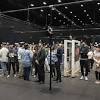UCL
2024 - 9 - 18How a Simulated Art Gallery Can Shape Real Life Spaces! 🎨
academic research - art gallery - mental health - public spaces - soccer highlights - telecommunications - UCL - UEFA Champions League - YouTube HealthEver wondered how art galleries can be designed better? Discover UCL's fascinating experiment that tracks movement patterns in a simulated gallery!
In a groundbreaking experiment, scientists at University College London (UCL) have taken a unique approach to understanding how people interact with art galleries. By designing a simulated art gallery, researchers tracked the movement of participants and observed their behaviors, providing key insights into how gallery spaces can be optimized for better visitor experiences. This study highlights the importance of design in public spaces, where every element can influence how people engage with art and each other.
The findings of this study reveal that the layout, lighting, and even the placement of artworks can significantly impact foot traffic and audience engagement. For instance, researchers noted that open spaces encouraged more interaction and conversations among visitors. Conversely, narrow pathways tended to create bottlenecks where people clustered, limiting their ability to appreciate the art fully. By understanding these behavioral patterns, designers can create more inviting and engaging environments for everyone involved.
As public spaces are constantly evolving, the insights from UCL's study extend beyond galleries. They also emphasize the role that such designs can play in community areas, museums, corporate spaces, and educational institutions. By ensuring that these environments foster interaction and enjoyment, institutions can better serve their audiences' needs, ultimately leading to more fulfilling experiences. Imagine a world where public spaces not only serve their purpose but also enhance social interactions and creativity!
Art, after all, is about connection, and it seems that the design of the spaces we create can either enhance or hinder that connection. The next time you step into an art gallery or public space, take a moment to observe how the design impacts your experience. You might even feel inspired to help shape the spaces around you!
Did you know that the first public art gallery was established in 1765 in London? Named the British Museum, it was designed to make art accessible to everyone, regardless of social standing. Another fun fact is that modern art galleries often employ professionals known as exhibit designers or curators, who are specifically tasked with not just showcasing art, but creating an emotional journey for visitors through spatial design. Spaces matter!

UCL 'art gallery' experiment aims to inform better design of spaces ... (The Engineer)
An experiment conducted by scientists at UCL has tracked movement through a simulated art gallery, providing insights into how people interact with public ...

UCL Swift bolsters portfolio with Accurate Connections deal (LightWave Online)
The acquisition will enhance the fiber termination provider's solutions for the datacom and telecom industry segments.

UCL partners with YouTube Health to improve access to mental ... (Health Tech Newspaper)
The collaboration aims to train more than 100 clinical academic staff in creating their own content with the view to develop a “clinical creators network” at ...

ORF deals with Canal Plus to show UCL highlights (Sportcal)
Austrian public-service broadcaster ORF will provide free-to-air highlights of European soccer's UEFA Champions League (UCL) club competition this season ...
Explore the last week
- 2025 - 01 - 26, 9 topics across 86 articles.
- 2025 - 01 - 25, 13 topics across 104 articles.
- 2025 - 01 - 24, 11 topics across 99 articles.
- 2025 - 01 - 23, 17 topics across 103 articles.
- 2025 - 01 - 22, 10 topics across 74 articles.
- 2025 - 01 - 21, 20 topics across 160 articles.
- 2025 - 01 - 20, 18 topics across 129 articles.